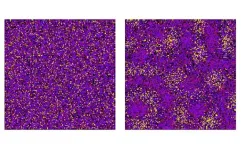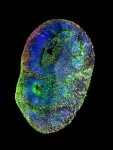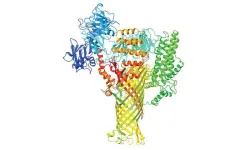When biomes turn unhealthy, either by invasion of outside pathogens, or a major change in the relative numbers of the microbial species present, a dysbiosis, or imbalance in the microbiota, occurs. This dysbiosis can alter human metabolism and cause inflammation, which has been linked to the tissue damage seen in ulcerative colitis, rheumatoid arthritis and many other chronic inflammatory diseases.
Studying 130 samples from the donated brains of 32 people – 16 with Alzheimer’s and 16 age-matched controls without the disease, the Drexel researchers found bacterial flora in all the brains— but the Alzheimer’s brains showed profoundly different bacterial profiles compared to their age-matched controls.
The group used full-length 16s ribosomal RNA gene sequencing, a technique that can detect any and all bacterial species present in a sample. In this process, the researchers pinpointed disease-specific sets of bacteria in almost all of the Alzheimer’s-affected brains, suggesting these groups of bacteria are strong predictors of the disease.
The authors detected five brain microbiomes, four that are hypothesized to be present at different times in the evolution of the Alzheimer’s-afflicted brains. The authors said it is likely that the observed Alzheimer’s microbiomes evolve to become more pathogenic as the disease progresses with the later stages characterized as a pathobiome. The authors hypothesize that the brain begins with a healthy biome, but as the disease develops, the healthy biome is supplanted as a new set of microbes replace the original healthy ones with the eventual emergence of the Alzheimer’s pathobiome.
Samples from both sets of brain samples were drawn from the frontal and temporal lobes and entorhinal cortex. Based on the random distribution of microbiomes requiring delivery all over the brain, the results were consistent with failure in one or more of the brain’s networks; however it too soon to tell if the observed distribution patterns result from a leaky blood-brain barrier, the brain's glymphatic system, or synaptonemal transmission that allowed bacteria, including Cutibacterium acnes (formerly called Proprionibacterium acnes), Methylobacterium, Bacillus, Caulobacter, Delftia, and Variovora to enter the brain. In Alzheimer’s brain samples, the researchers noted, these pathogenic bacteria appeared to have overpowered and replaced Comamonas sp. bacteria, which are associated with a dementia-free brain.
“Perhaps destruction of the Comamonas bacteria, part of a healthy brain microbiome, is the first sign of impending dementia,” said Garth D. Ehrlich, PhD, a professor in the College of Medicine, who was a senior author of the paper. “We’re now coming up with the questions to guide future studies, but the hypotheses are many. The culprit could be bacteria or something else – like fungi, parasites, or viruses – at the same time.”
When a patient has Alzheimer’s, they experience inflammation in the brain characterized by deposits of amyloid beta which are formed by an increase in the production of the Aβ peptide (an antimicrobial peptide, which is part of the innate immune response) resulting in amyloid plaques in the brain. Similarly, Alzheimer’s is characterized by tau protein tangles found with the cells which are characterized by abnormal phosphorylation which ultimately lead to the destruction of synapses and neurons, but which have also been demonstrated to help stop the spread of pathogens in the brain.
These protein-oriented pathologies – known as the “amyloid cascade hypothesis”— have been the main focus of Alzheimer’s research for decades. Recently, studies are challenging that model by suggesting a role for bacteria, fungi and viruses, and immune system and brain inflammation, which some researchers call the “pathogen hypothesis.”
“Multiple studies have now shown the presence of bacteria in Alzheimer’s-afflicted brains,” said Jeffrey Lapides, PhD, an adjunct associate professor in the College of Medicine, and a senior author of the study. “Perhaps plaques, whose constituents have anti-microbial properties in vitro, aren’t the direct cause of Alzheimer’s, but instead are a response to bacteria in the brain – some benign, some pathogenic, perhaps causing damage that has not yet resulted in cognitive deficits, making them part of the pathobiome.”
This unique set of bacteria found in the Alzheimer’s-afflicted brains are also commonly found in brains afflicted with the neurodegenerative disease amyotrophic lateral sclerosis, or ALS -- suggesting that this set of bacteria may contribute to more than one neurological illness.
The next step for this research, according to the authors, is to study the possible contributions of other microbes and figure out what happened, physiologically, in the brain to make this microbiome change over time.
“The development of Alzheimer’s and other dementias is complex and likely involves the interaction of many systems,” said Ehrlich. “I’m a believer in the more infections you get in the brain, the higher your risk of Alzheimer’s. There are many pathogens that likely increase the risk. This pathobiome is not the whole answer, but it’s a piece of the puzzle.”
The exact location of the problematic bacteria within the brain is also an open question, according to the team. Researchers need to know more precisely where the bacteria are to better understand the role they are playing. The authors found that when an unhealthy pathobiome is located in the frontal lobe, the likelihood of Alzheimer’s disease being present is very high. It’s less likely to develop in the temporal lobe.
Despite the many unknowns, the authors said this is a significant step forward for studying the microbiome.
“The strength of our work is also to combine a breakthrough sequencing technology and the most advanced and innovative statistical approaches,” said lead author Yves Moné, PhD, a research associate in the College of Medicine. “Microbiome data analysis is notoriously challenging without any gold standard and this work could contribute significantly to the field of microbiome data analysis.”
An estimated 6.7 million Americans have Alzheimer’s and that number is expected to roughly double by 2050, according to the Alzheimer’s Association. The National Institutes of Health increased funding for dementia and Alzheimer’s research in recent years, currently dedicating a $3.7 billion annual budget for diagnosis and drug development, along with other studies into other possible therapies.
Ehrlich and colleagues are members of the Alzheimer’s Pathobiome Initiative, a newly formed group of researchers developing pilot studies that look for infections in dementia and Alzheimer’s patients, with the eventual aim of finding out whether giving infected patients anti-microbial drugs prior to the onset of symptoms slows or prevents disease symptoms.
In addition to Ehrlich and Lapides, additional authors on this paper include lead author Yves Moné, and Joshua P. Earl, Jarosław E. Król, Azad Ahmed, and Bhaswati Sen, all from Drexel.
The work was funded by the Oskar Fischer Project, a philanthropy funded by James Truchard, PhD, and from the Bill and Marion Cook Foundation and Drexel’s College of Medicine.
END




